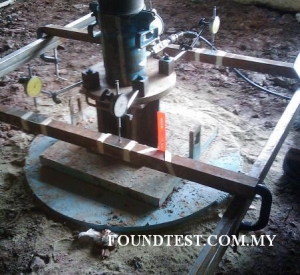Plate Bearing Test
Plate Bearing Test (PBT) Overview
The Plate Bearing Test, PBT (also known as the Plate Loading Test) is a widely used method for determining the safe bearing capacity of the ground (measured in kN/m²). It involves applying a direct load (from counter weights, such as concrete blocks or heavy machinery) onto the ground surface using a steel plate as contact pressure point, making it particularly suitable for designing shallow foundations such as footings.
Testing Standards and Setup
This test is conducted in accordance with Clause 29 of BS 5930:1981. The size of the steel plate can vary depending on site requirements and constraints. A kentledge frame and appropriate counterweights are set up on-site to enable the application of load to the steel plate using a hydraulic jack.
Test Procedure
- Loading Process:
- The load (bearing pressure) is applied in several equal increments.
- Each increment is held for a specified period until the required test load is reached.
- Unloading Process:
- The load is removed in equal decrements, following the same sequence as the loading phase.
- Data Recording:
- The settlement or movement of the plate is recorded throughout the loading and unloading phases.
- This data is used to produce the final test report, which consist of tabulated data and chart, providing critical insights into the ground’s bearing capacity.
This test offers a reliable method for assessing ground stability, ensuring the safe design and performance of shallow foundations.
For more information, quotation or site appointment, please call us or drop us a message here.

Plate Bearing Test
